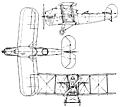|
| The Blackburn was an ugly carrier-borne Fleet spotter-reconnaissance biplane, accommodating a pilot in an open cockpit in front of the upper wing leading edge, a wireless operator/gunner and a navigator/observer. The latter crew members were provided with a cabin inside the deep fuselage and only needed to venture out into the open for observation or to use the rear-mounted Lewis machine-gun. Thirty production Blackburn Is, with 335kW Napier Lion IIB engines, were built. The type first entered service on board HMS Eagle in 1923. These were followed by 29 346kW Napier Lion-engined Blackburn IIs, entering service in 1926. All were replaced by Fairey IIIFs in 1931.

| MODEL | Blackburn II |
| WEIGHTS |
| Take-off weight | 3,022 kg | 7 lb |
| DIMENSIONS |
| Wingspan | 13.87 m | 46 ft 6 in |
| Length | 11.02 m | 36 ft 2 in |
| PERFORMANCE |
| Max. speed | 157 km/h | 98 mph |
| ARMAMENT | 2 x 7.7mm machine-guns |
 | A three-view drawing (800 x 715) |
| Bernard Rumbold, e-mail, 11.02.2021 22:48 A handful in a cross wind landing I bet!! reply | | LR, e-mail, 23.11.2020 07:07 Klaatu:
I don't think you should discount Blackburn's talent for ugliness. Compare the R.1 to the Fairey IIIF which replaced it, or even to the Fairey IIID which was its contemporary. If it was really necessary to provide a place for the radio operator to take a stroll, I'm sure a more corpulent Fairey III still wouldn't be that hard on the eyes. reply | | Daniel Kaplan, e-mail, 03.12.2014 03:08 I've been an avid aviation enthusiast for decades and never seen this before. It must have been very impressive seeing that huge plane operate from a carrier deck. reply | | Klaatu83, e-mail, 23.09.2012 18:02 The Blackburn Blackburn was certainly a strange-looking machine, but there were valid reasons why it looked the way it did. In judging aircraft such as this one must maintain a perspective as to the period in which they were developed and the mission that they were expected to fulfill.
During the 1920s the Navy's principal weapon was considered to be the big guns of the battleships, and aircraft carriers were regarded as no more than mere auxiliary support to them. With that in mind, this aircraft was designed specifically to serve as a carrier-based observation platform from which to spot for the guns of the battleships. That was the reason it looked the way it did.
The requirement for which this airplane was designed stipulated a place from which an observer could obtain a good view of the fall of shot, as well as a large enclosed cabin from which a radio-operator could transmit the information to the battle-fleet. The pilot's cockpit also needed to be placed as far forward as possible, and clear of the wings, in order to afford a good view for landing onto the carrier deck. In spite of it's ungainly appearance, the Blackburn Blackburn did everything it was designed to do, and was considered to be a successful airplane. reply |
|
| | Sgt.KAR98, 11.02.2009 19:38 No,it�s the Nimrod. reply | | NICO, e-mail, 27.08.2008 14:34 I was searching for the ugliest aicraft ever. This is the one!
Cheers, Nico reply | | Matt Collins, 02.09.2007 05:36 BLEH!!! reply |
|
Do you have any comments?
|
| 
COMPANY
PROFILE
All the World's Rotorcraft
|









Just wanted to say thank you for those very informative comments, it really helps to have a feel for the time frame and uses of these early aeroplanes. I came across it whist I was identify a drawing from my late fathers “aeroplane stuff “ . Dad was passionate about aeroplanes in general and Blackburn in particular. He was also a keen aero model maker. The drawing I have is dated 1.9.22.
Thanks again.
I am going to pass all of the stuff I have to the BAE archive at Brough, may i include a print of your comments when I take the stuff to them.
Many thanks again
Sheila Coy
reply